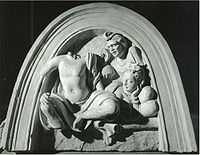Hadda, Afghanistan
Haḍḍa (Pashto: هډه) is a Greco-Buddhist archeological site located in the ancient region of Gandhara, near the Khyber Pass, ten kilometers south of the city of Jalalabad in today's eastern Afghanistan.
Background
Some 23,000 Greco-Buddhist sculptures, both clay and plaster, were excavated in Haḍḍa during the 1930s and the 1970s. The findings combine elements of Buddhism and Hellenism in an almost perfect Hellenistic style.

 | ||||||||||||||||||||||||||||||||||||||||||
| History of Afghanistan | ||||||||||||||||||||||||||||||||||||||||||
|---|---|---|---|---|---|---|---|---|---|---|---|---|---|---|---|---|---|---|---|---|---|---|---|---|---|---|---|---|---|---|---|---|---|---|---|---|---|---|---|---|---|---|
| Timeline | ||||||||||||||||||||||||||||||||||||||||||
|
Ancient
|
||||||||||||||||||||||||||||||||||||||||||
|
Medieval
|
||||||||||||||||||||||||||||||||||||||||||
|
Modern
|
||||||||||||||||||||||||||||||||||||||||||
| ||||||||||||||||||||||||||||||||||||||||||
Although the style of the artifacts is typical of the late Hellenistic 2nd or 1st century BCE, the Haḍḍa sculptures are usually dated (although with some uncertainty), to the 1st century CE or later (i.e. one or two centuries afterward). This discrepancy might be explained by a preservation of late Hellenistic styles for a few centuries in this part of the world. However it is possible that the artifacts actually were produced in the late Hellenistic period.
Given the antiquity of these sculptures and a technical refinement indicative of artists fully conversant with all the aspects of Greek sculpture, it has been suggested that Greek communities were directly involved in these realizations, and that "the area might be the cradle of incipient Buddhist sculpture in Indo-Greek style".[1]
The style of many of the works at Haḍḍa is highly Hellenistic, and can be compared to sculptures found at the Temple of Apollo in Bassae, Greece.
The toponym Haḍḍa has its origins in Sanskrit haḍḍa n. m., "a bone", or, an unrecorded *haḍḍaka, adj., "(place) of bones". The former - if not a fossilized form - would have given rise to a Haḍḍ in the subsequent vernaculars of northern India (and in the Old Indic loans in modern Pashto). The latter would have given rise to the form Haḍḍa naturally and would well reflect the belief that Haḍḍa housed a bone-relic of Buddha. The term haḍḍa is found as a loan in Pashto haḍḍ, n., id. and may reflect the linguistic influence of the original pre-Islamic Indian population of the area.
Works of art
A sculptural group excavated at the Haḍḍa site of Tapa-i-Shotor represents Buddha surrounded by perfectly Hellenistic Herakles and Tyche holding a cornucopia.[2] The only adaptation of the Greek iconography is that Herakles holds the thunderbolt of Vajrapani rather than his usual club.
Other attendants to the Buddha have been excavated which display manifest Hellenistic styles, such as the "Genie au Fleur", today in Paris at the Guimet Museum.[3]
Buddhist scriptures
It is believed the oldest surviving Buddhist manuscripts-indeed the oldest surviving Indian manuscripts of any kind-were recovered around Haḍḍa. Probably dating from around the 1st century CE, they were written on bark in Gandhari using the Kharoṣṭhī script, and were unearthed in a clay pot bearing an inscription in the same language and script. They are part of the long-lost canon of the Sarvastivadin Sect that dominated Gandhara and was instrumental in Buddhism's spread into central and east Asia via the Silk Road. The manuscripts are now in the possession of the British Library.
Destruction
Haḍḍa is said to have been almost entirely destroyed in the fighting during the Civil war in Afghanistan.
Gallery
-
Head of the Buddha, Haḍḍa.
-
Greek clothes, amphoras, wine and music, 1st century CE, Haḍḍa.
-
Portraits from Haḍḍa, 3rd century CE.
-
Decorative scrolls from Haḍḍa.
-
The Greek god Atlas, supporting a Buddhist monument, Haḍḍa.
-
Polychrome Buddha, 2nd century CE, Haḍḍa.
-
Young woman, 3-4th century, Haḍḍa.
-

"Laughing boy" from Haḍḍa.
-

A sculpture from Hadda, 3rd century CE.
There were also many works of art lost as a result of the civil war. One of the worst of the casualties was the loss of two statues. The Red Mountain range in Bamiyan that once housed two giant statues of the Buddha, on cliff faces, besides smaller structures of archaeological significance. The two big statues, dating back to the 5th or 6th century CE, were the largest of all Buddhist statues so far attested in the world. Only remnants of these statues were left behind.
See also
- Indus Valley Civilization* List of Indus Valley Civilization sites
- List of inventions and discoveries of the Indus Valley Civilization
- Hydraulic engineering of the Indus Valley Civilization
- Kanwari
- Banawali a neighbouring IVC site
- Mundigak — archaeological site in Kandahar Province
- Surkh Kotal — archaeological site in Baghlan Province
- Mes Aynak — archaeological site in Logar Province
- Mehrgarh — archaeological site in Bolan
- Sheri Khan Tarakai — archaeological site in Bannu
- Greco-Buddhism
- History of Buddhism
- Chakhil-i-Ghoundi Stupa
References
External links
| Wikimedia Commons has media related to Hadda. |





